Abstract
Advanced aerospace structures are subjected to extremely harsh working environment, including of mechanical, acoustic, thermal, and aerodynamic loads. These combined loads can make the structures exhibit complex response, which has already attracted increasing concern in the design of advanced aerospace structures. To tackle the problem, a finite element model (FEM) by discretizing the theoretical differential equation is established to calculate the dynamic response of thin-walled structures under combined thermal and acoustic loads. The numerical analysis indicates that three types of nonlinear responses of the thin plate under combined thermal-acoustic loads are obtained, and the mechanism of snap-through is revealed through two ways: thermal buckling analysis and thermal modal analysis. which can be used to explain the nonlinear response characteristics.
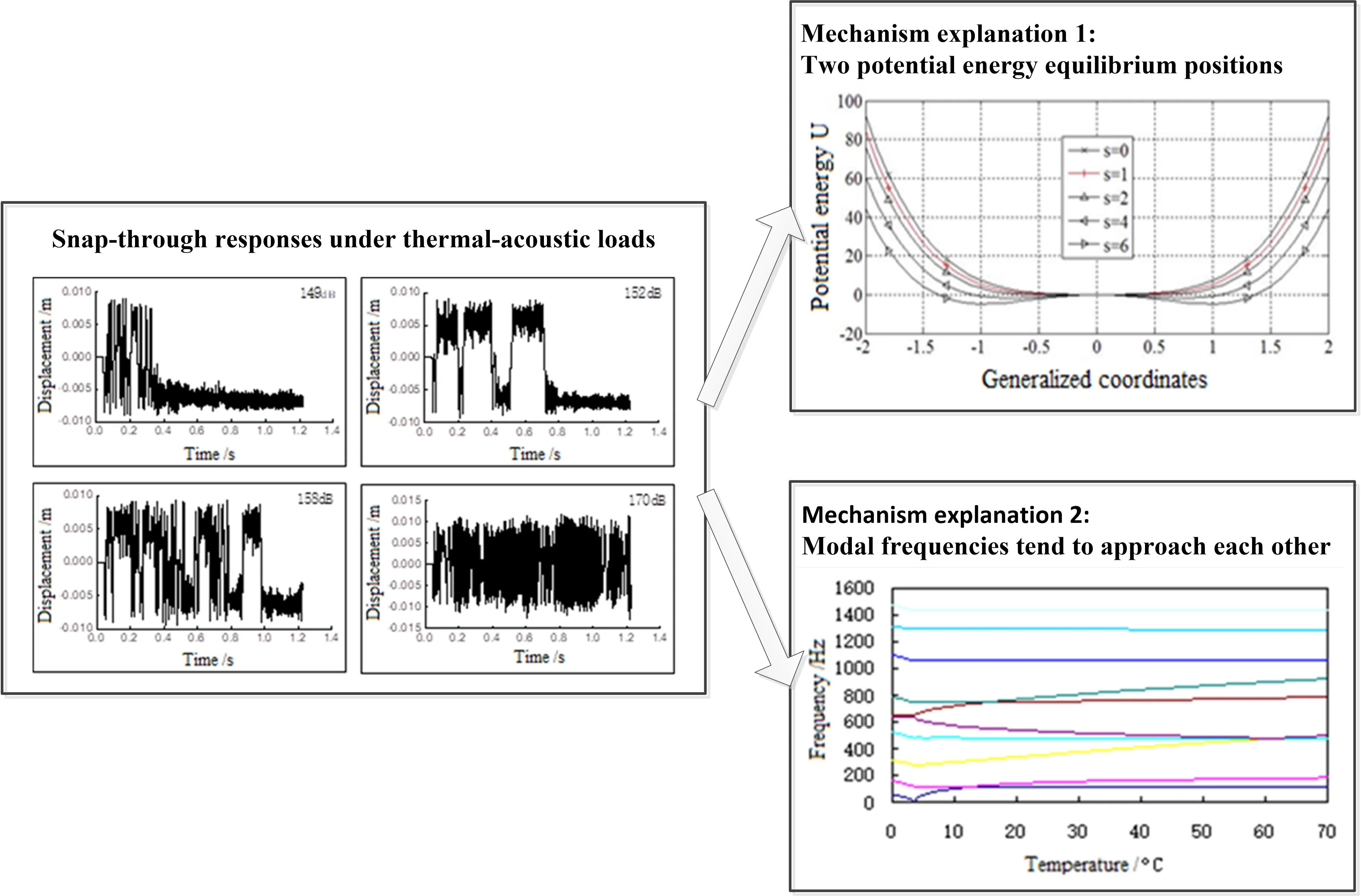
Highlights
- FEM model by discretizing the theoretical differential equation is established to calculate the dynamic response of thin-walled structures under combined thermal and acoustic loads.
- Three types of nonlinear snap-through response of thin-walled structures under thermal-acoustic loads are obtained.
- The mechanism of snap-through is revealed through two ways: thermal buckling analysis and thermal modal analysis.
1. Introduction
Aerospace vehicles widely adopt thin-walled structures to reduce structural weight, such as missile wings, warhead casings, aeroengine combustor flame tube and afterburner liner, etc. These structures bear complex combination of mechanical, acoustic, thermal, and aerodynamic loads during operation. The impact of combined loads on the fatigue life of thin-walled structures is considerably more severe than the simple superposition of individual loads. These combined loads may lead to nonlinear structural response characteristics [1]. Specifically, thin-walled structures are prone to snap-through response under the combined thermal-acoustic loads, and the reverse stress generated by the snap-through response can reduce the structure's fatigue life dramatically [2]. Therefore, it is necessary to probe into the nonlinear response of thin-walled structures under thermal-acoustic loads.
Thin-walled structures first experience thermal buckling under the increasing thermal load, and the resulting geometric nonlinearity increases the structural stiffness. Then, the post buckling structures will exhibit different response characteristics excited by different levels of sound pressure. Ng and their research group first observed the phenomenon of snap-through in thin-walled plates in the thermal buckling state under strong noise conditions. Subsequently, they proposed the use of a single degree-of-freedom (SDOF) model to analyze the statistical response characteristics of thin-walled plates under thermal-acoustic loads, and pointed out the drift of resonance frequency and the broadening of resonance band in nonlinear response [3]. Jon Lee conducted extensive research on the statistical responses of displacement and strain by using the SDOF model, indicating that displacement and strain follow the Fokker-Planck distribution [4]. Mei has researched buckling and dynamic response problems in aerospace structures under thermal-acoustic loads by using FEM method for three decades, which focused on the application of iterative method in response solving [5]. Sha et al. have conducted extensive simulations on the thermal-acoustic load responses of thin-walled structures and also discovered the snap-through response [6, 7]. The above researches focus on the analysis of structural dynamic response under thermal-acoustic loads, while there is relatively little research on the modal characteristics of thermal structures and their impact on the mechanism of snap-through response.
The objective of this paper is to predict the nonlinear snap-through response of thin-walled structures under thermal-acoustic loads and reveal its mechanism. A two-edge fixed-supported rectangular plate is selected as the modelling object. The thermal load is simplified as constant throughout the plate, and the acoustic load is simulated using band limited Gaussian white noise according to a modified triangle series method. The FEM model of the plate by discretizing the theoretical large deflection differential equation is established to simulate the nonlinear response under thermal-acoustic loads. The mechanism of nonlinear snap-through response is researched through two ways: thermal buckling analysis and thermal modal analysis. The findings provide valuable insights for the design of structures operating in high-temperature environments, especially in structural anti-acoustic fatigue design.
2. Theoretical model of thermal-acoustic vibration for thin plate
2.1. Governing equations of thin plate under thermal-acoustic loads
The well-known von Karman large deflection equation with thermal and acoustic loads can be derived by the analysis of forces and moments in the plate:
where is bending stiffness, is the thickness of the plate, is Poisson ratio, is the temperature gradient along , is the random pressure used to simulate acoustic load, is Airy stress function, is transverse deflection of the middle plane.
The corresponding strain compatibility equation can be represented as:
where is Young’s modulus, is bi-harmonic operator, is average temperature along the plate thickness .
2.2. FEM equation of thin plate under thermal-acoustic loads
It’s very difficult to directly solve Eq. (1) and Eq. (2), which can be discretized into dynamic FEM equation as:
where, is the mass matrix, is the damping matrix, is the linear stiffness matrix, and are first-order and second-order nonlinear stiffness matrices respectively, is the displacement vector, is the acoustic load vector, The influence of thermal load is reflected on both sides of Eq. (3), i.e. represents the stiffness term induced by thermal stress, and is the thermal load vector.
The above stiffness terms can be combined into one term, and the same applies to the load terms, so Eq. (3) takes the simplified form as:
By employing the Newmark-Beta integration method, the dynamic response of the thin plate under the combined thermal-acoustic loads can be simulated.
2.3. Determination of thermal-acoustic loads
This paper assumes that the thermal load on the thin plate is a uniformly distributed temperature field, and there is no temperature gradient considered. The buckling coefficient can be prescribed as:
where is the ambient temperature, is the critical buckling temperature.
The acoustic load is a band-limited Gaussian white noise excitation, with its amplitude following the zero-mean Gaussian distribution and its power spectral density (PSD) that is uniformly distribution. The effective value of the sound pressure is:
The PSD can be given by:
where is band-width represented by angular frequency.
3. Numerical example
3.1. Analysis model
This paper adopts the sequentially coupling method to address the thermal-acoustic vibration problem. A typical aluminum alloy thin plate is selected as the research model, which had clamped boundary conditions at both short edges. The length, width, and height of the plate are 457 mm, 25 mm and 2.3 mm, respectively. The material parameters are Young’s modulus 7.3×1010 Pa, density 2763 kg/m³, Poisson’s ratio 0.3, and linear expansion coefficient 22.3×10-6 °C.
3.2. Thermal buckling analysis of thin plate
Using Galerkin’s approach, the large deflection equation Eq. (1) can be reduced to a second-order ordinary differential equation in modal coordinates. In order to illustrate the basic characteristic and explain the mechanism of snap-through, the non-dimensional single-mode plate equation can be derived as:
where, is the generalized coordinate of displacement in , , , is the aspect ratio of the plate, i.e. the ratio of length to width of the plate, is the damping ratio, and is the acoustic load.
The potential energy of Eq. (8) can be given by:
When , , and 1, 2, 4, 6, the potential energy changes as shown in Fig. 1. According to Eq. (9) and Fig. 1, when , the potential energy curve has a single minimum position, indicating that the thin plate has only one stable equilibrium position. However, when , the thin plate enters thermal buckling state, and the potential energy curve has two lowest positions, implying that the thin plate has two stable equilibrium positions. These two equilibrium positions are symmetric about the initial geometrical configuration. This means that when the SPL of external acoustic load excitation is small, the thin plate may keep a small vibration near one of the two equilibrium positions. As the SPL of acoustic load increases to a certain level, vibration of the thin plate would shuttle back and forth between the two equilibrium positions, resulting in snap through phenomenon.
When the SPL exceeds the level required for snap-through, but is not too high, there are some random and intermittent short time periods due to the randomness of the acoustic load. At this time, the SPL is not sufficient to drive the vibration of the plate to jump to another equilibrium position without snap-through happened, which means the plate can only vibrate at one equilibrium position with small amplitude. Conversely, there are also some random and intermittent short time periods, during which the SPL has ability to drive the large amplitude vibration of the plate to jump to the other equilibrium position with snap-through happened. We call the above vibration as intermittent snap-through.
If the SPL is high enough, high-intensity acoustic load has sufficient ability to drive the plate to vibrate significantly between two equilibrium positions at any time. In this case, the vibration response is called continuous snap-through.
Fig. 1Potential energy
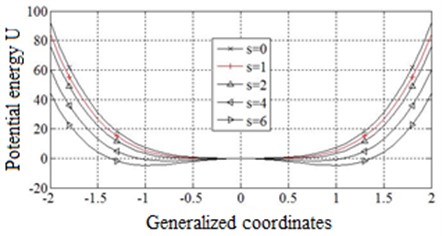
3.3. Thermal modal analysis of thin plate
In pre-buckling state of the plate, the in-plane thermal stress caused by the temperature rise decreases the stiffness of the structure. Thermal buckling occurs at the critical buckling temperature , which leads to a decrease in structural stiffness to zero. Then, as the temperature continues to rise, unrecoverable buckling deflection will be arised, and the plate will enter post-buckling state. In post-buckling stage, the structural stiffness will increase to a certain extent.
The critical buckling temperature of the thin plate has been calculated to be 3.76 °C with setting the reference temperature 0 °C. The first 3 modal shapes for pre-buckling with 0, post-buckling with 5.45 and 19.07 are shown in Fig. 2. The modal shapes are significantly different between pre-buckling and post-buckling, especially in higher order modal shapes at more serious post-buckling state. The 3rd modal shape has become a bending-torsion coupling mode, which means higher order modes would impact the dynamic thermal-acoustic response.
The first 10 modal frequencies are shown in Fig. 3. In general, the modal frequencies decrease with the increasing temperature before thermal buckling, and reach their minimum values at critical buckling temperature (the 1st frequency is 0). After thermal buckling, due to the influence of thermal hardening effect, the frequencies increase with the temperature further rising. Moreover, the modal frequencies tend to approach each other as the temperature rising in post-buckling, which implies resonance would be induced at the concentrative frequencies and the dynamic snap-through response may be occurred.
Fig. 2First three modal shapes of thin plates under different buckling coefficients
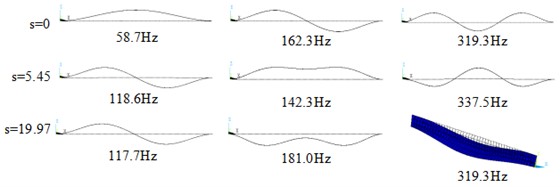
Fig. 3Changes in the first ten modal frequencies of the thin plate
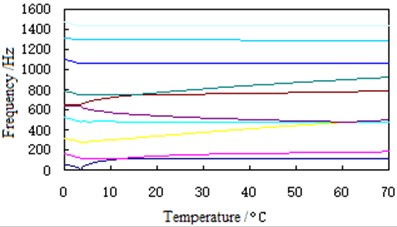
3.4. Thermal-acoustic vibration response of thin plate
In simulated condition settings, taking the reference temperature and the structural temperature as 0 °C and 19.44 °C respectively, the structural temperature, corresponding 5.17, is loaded linearly on the plate within 0.3 seconds, and the acoustic load is loaded on the plate in the whole simulated time period of 1.224 seconds. Dynamic responses of the thermal plate are obtained under SPLs of 149 dB, 152 dB, 158 dB, and 170 dB in the time domain. The transverse displacements of the midpoint in plate under different SPLs are shown in Fig. 4.
Fig. 4Time history displacements of the thin plate under different sound pressures
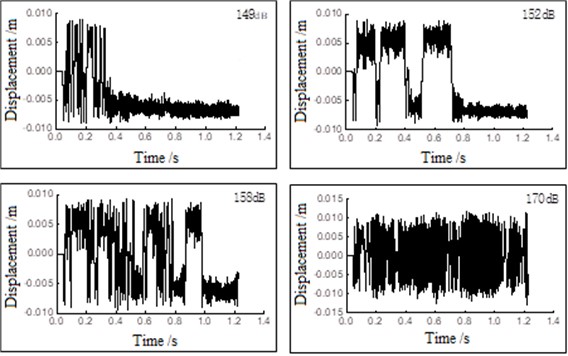
It can be seen that the vibration of the plate takes place only around a single equilibrium position with the SPL of 149 dB and there is no snap-through. When the SPL increases to 152 dB, the plate not only vibrates slightly around each equilibrium position, but also shuttles back and forth intermittently between the two balanced positions. The intermittent snap-through response occurs in this case, resulting in the reversed stress that weakens the fatigue life of the structure. When the SPL rises to 158 dB, although it’s still intermittent snap-through at this time, the frequency of snap-through significantly increases. At last, a continuous snap-through response occurs when the SPL is up to 170 dB.
4. Conclusions
This paper simulates and analyzes the nonlinear snap-through response of thin-walled structures under thermal-acoustic loads and reveals its mechanism innovatively through two approaches: thermal buckling analysis and thermal modal analysis. The main conclusions are as follows:
1) In pre-buckling state, there is a single vibration equilibrium position in thin plate. In post-buckling state, there exist two vibration equilibrium positions.
2) Three types of nonlinear responses are obtained: a small amplitude vibration around one of the two equilibrium positions, an intermittent snap-through shuttled back and forth between two equilibrium positions, a continuous snap-through response at any time between two equilibrium positions.
3) Modal frequencies decrease with the increasing temperature in pre-buckling, and reach minimum values at critical buckling temperature (the 1st frequency is 0). Due to the influence of thermal hardening effect, the frequencies increase with the temperature further rising in-post buckling.
4) The mechanism of snap-through is revealed through two ways: by thermal buckling analysis, two potential energy equilibrium positions are obtained and by thermal modal analysis, modal frequencies tend to approach each other.
References
-
Z. Dang and Z. Mao, “Dynamic response analysis of a thin-walled rectangular plate subjected to thermoacoustic loadings,” Archives of Thermodynamics, Vol. 41, No. 1, pp. 151–174-151-174, Jul. 2023, https://doi.org/10.24425/ather.2020.132953
-
J. Wang, F. Zhao, Y. Sha, and S. Gu, “Fatigue life research and experimental verification of superalloy thin-walled structures subjected to thermal-acoustic loads,” (in Chinese), Chinese Journal of Aeronautics, Vol. 33, No. 2, pp. 598–608, Feb. 2020, https://doi.org/10.1016/j.cja.2019.09.012
-
C. F. Ng, “The nonlinear acoustic response of thermally buckled plates,” Applied Acoustics, Vol. 59, No. 3, pp. 237–251, Mar. 2000, https://doi.org/10.1016/s0003-682x(99)00009-2
-
J. Lee, “Topology of the four-mode strain energy of thermally buckling plates,” Journal of Thermal Stresses, Vol. 25, No. 9, pp. 813–857, Jan. 2011, https://doi.org/10.1080/01495730290074441
-
C. Mei, “Three decades’ interesting experience in nonlinear finite element formulation development and aerospace applications,” in Proceedings of the 7th International Conference on Recent Advances in Structural Dynamics, pp. 37–42, 2007.
-
Y.-D. Sha, L. Zhu, X.-B. Jie, X.-C. Luan, and F.-F. Feng, “Nonlinear random response and fatigue life estimation of curved panels to non-uniform temperature field and acoustic loadings,” Journal of Vibration and Control, Vol. 22, No. 3, pp. 896–911, May 2014, https://doi.org/10.1177/1077546314530179
-
Y. Sha et al., “Random vibration response calculation and fatigue analysis of thin-walled structures under heat flux environment,” (in Chinese), Journal of Aerospace Power, Vol. 35, No. 7, pp. 1402–1412, Jul. 2020, https://doi.org/10.13224/j.cnki.jasp.2020.07.008
About this article
The authors have not disclosed any funding.
The datasets generated during and/or analyzed during the current study are available from the corresponding author on reasonable request.
The authors declare that they have no conflict of interest.
